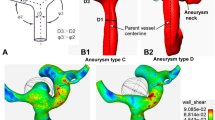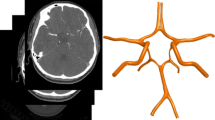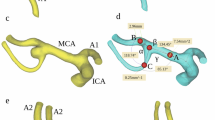Abstract
Background
Morphological studies investigating the intracranial-extradural internal carotid artery with moyamoya disease have not been reported. We designed this case–control study to investigate the morphological differences of the internal carotid artery with moyamoya disease, and to clarify the contributions of these differences to the resultant fluid dynamics.
Methods
Patients with moyamoya disease and normal controls were assigned to each group. The vascular tortuosity of internal carotid artery was measured with three-dimensional rendering using magnetic resonance angiography. By computational fluid dynamics, hemodynamic characteristics were simulated and compared between two groups.
Results
Distances were measured from the carotid canal to the siphon. A shorter actual distance was observed in the moyamoya group (p = 0.0170). Vascular tortuosity was significantly low in moyamoya patients showing lower curvature angles in the petrous and intra-cavernous segments (p = 0.0012). Less blood flowed (p < 0.0001) through the narrower internal carotid artery (p < 0.0001) in the moyamoya group at the carotid canal level. The blood flow velocities were not significantly different (p = 0.2332). Faster blood flow and higher wall shear stress in the internal carotid artery bifurcation were verified with computational fluid dynamics.
Conclusions
Significant morphological differences were confirmed to exist in the intracranial-extradural internal carotid artery of moyamoya patients. These differences might influence the hemodynamics around the bifurcation of the internal carotid artery.




Similar content being viewed by others
References
Charbel F, Misra M, Clarke M, Ausman J (1997) Computer simulation of cerebral blood flow in moyamoya and the results of surgical therapies. Clin Neurol Neurosurg 99:S68–S73
Dolan JM, Kolega J, Meng H (2013) High wall shear stress and spatial gradients in vascular pathology: a review. Ann Biomed Eng 41:1411–1427
Hosoda Y, Ikeda E (1999) Pathology of spontaneous occlusion of the circle of Willis (cerebrovascular Moyamoya disease). Neuropathology 19:137–138
Jung K-H, Chu K, Lee S-T, Park H-K, Kim D-H, Kim J-H, Bahn J-J, Song E-C, Kim M, Lee SK (2008) Circulating endothelial progenitor cells as a pathogenetic marker of moyamoya disease. J Cereb Blood Flow Metab 28:1795–1803
Kaku Y, Morioka M, Ohmori Y, Kawano T, Kai Y, Fukuoka H, Hirai T, Yamashita Y, Kuratsu J-I (2012) Outer-diameter narrowing of the internal carotid and middle cerebral arteries in moyamoya disease detected on 3D constructive interference in steady-state MR image: is arterial constrictive remodeling a major pathogenesis? Acta Neurochir (Wein) 154:2151–2157
Karunanithi K, Han C, Lee CJ, Shi W, Duan L, Qian Y (2015) Identification of a hemodynamic parameter for assessing treatment outcome of EDAS in Moyamoya disease. J Biomech 48:304–309
Kim JH, Jung JH, Phi JH, Kang HS, Kim JE, Chae JH, Kim SJ, Kim YH, Kim YY, Cho BK, Wang KC, Kim SK (2010) Decreased level and defective function of circulating endothelial progenitor cells in children with moyamoya disease. J Neurosci Res 88:510–518
Kono S, Oka K, Sueishi K (1990) Histopathologic and morphometric studies of leptomeningeal vessels in moyamoya disease. Stroke 21:1044–1050
Kuroda S, Houkin K (2008) Moyamoya disease: current concepts and future perspectives. Lancet Neurol 7:1056–1066
Lee JY, Kim SK, Cheon JE, Choi JW, Phi JH, Kim IO, Cho BK, Wang KC (2013) Posterior cerebral artery involvement in moyamoya disease: initial infarction and angle between PCA and basilar artery. Childs Nerv Syst 29:2263–2269
Liu W, Morito D, Takashima S, Mineharu Y, Kobayashi H, Hitomi T, Hashikata H, Matsuura N, Yamazaki S, Toyoda A (2011) Identification of RNF213 as a susceptibility gene for moyamoya disease and its possible role in vascular development. PLoS One 6:e22542
Obi S, Masuda H, Shizuno T, Sato A, Yamamoto K, Ando J, Abe Y, Asahara T (2012) Fluid shear stress induces differentiation of circulating phenotype endothelial progenitor cells. Am J Physiol Cell Physiol 303:C595–C606
Rafat N, Beck GC, Peña-Tapia PG, Schmiedek P, Vajkoczy P (2009) Increased levels of circulating endothelial progenitor cells in patients with Moyamoya disease. Stroke 40:432–438
Resnick N, Gimbrone M (1995) Hemodynamic forces are complex regulators of endothelial gene expression. FASEB J 9:874–882
Seol HJ, Shin DC, Kim YS, Shim EB, Kim SK, Cho BK, Wang KC (2010) Computational analysis of hemodynamics using a two-dimensional model in moyamoya disease. J Neurosurg Pediatr 5:297–301
Sho E, Komatsu M, Sho M, Nanjo H, Singh TM, Xu C, Masuda H, Zarins CK (2003) High flow drives vascular endothelial cell proliferation during flow-induced arterial remodeling associated with the expression of vascular endothelial growth factor. Exp Mol Pathol 75:1–11
Takebayashi S, Matsuo K, Kaneko M (1984) Ultrastructural studies of cerebral arteries and collateral vessels in moyamoya disease. Stroke 15:728–732
Acknowledgments
This study was supported by a grant of the Korea Healthcare Technology R&D Project, Ministry of Health & Welfare, Republic of Korea (HI10C2020)
Conflicts of interest
None.
Author information
Authors and Affiliations
Corresponding author
Rights and permissions
About this article
Cite this article
Kim, T., Bang, J.S., Kwon, OK. et al. Morphology and related hemodynamics of the internal carotid arteries of moyamoya patients. Acta Neurochir 157, 755–761 (2015). https://doi.org/10.1007/s00701-015-2367-y
Received:
Accepted:
Published:
Issue Date:
DOI: https://doi.org/10.1007/s00701-015-2367-y




